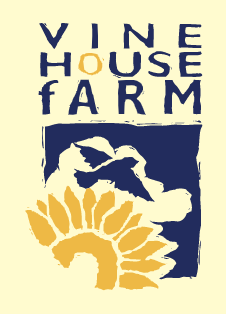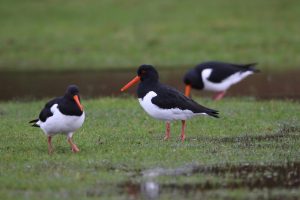
January was the first month to receive below average rainfall since last April. There have been only three drier Januarys in the last 50 years. It was also milder than average, with only three warmer Januarys in the past 50 years in 1975, 2007 and 2008. We only saw one frost, at -3°C on January 21st.

Here in South Lincolnshire, the land is gradually drying out and now we can get onto a few of our fields. Farmers are desperate to get crops out of the ground and to get some drilling done, which should have been completed last autumn. During the past month, we have lifted another 40 acres of potatoes, with just 35 acres in the ground. Some potatoes are going to supermarket shelves and some will make chips for MacDonald’s. Those for MacDonald’s may not keep very well so we have been talking to the factory, McCain Foods. They are a bit short of potatoes so they will accept the delivery in early February.
By the end of November, things were looking pretty grim for us potato-wise. If all farmers had all their potatoes out of the ground on time, the market price would probably be £100 lower than it is now and maybe we would be worse off than we are now. A 10% shortage or surplus of any of our crops, except sugar beet, makes a big difference to the price. If farmers make a good profit from a shortage, it encourages them to grow more of that crop. Therefore, within a year or two, that crop is in surplus and farmers may well make a loss on it.
There is only one buyer of our sugar beet crop – British Sugar. They set the price for the coming year and we then decide how much to grow. For the past few years they have given us a low price, so farmers did not grow so much. British Sugar thought there was still profit in the crop, so they hired land from farmers to grow it. However they have stopped growing it now, possibly because they didn’t make any money.
Brexit is now with us. Farmers, like everyone else, will be affected but exactly by how much we don’t yet know. Our acreage payment which we currently receive from the EU will be affected, which also supports the environmental stewardship schemes.
For the last three years, farmers have been fearing the worst about our acreage payment after Brexit. Michael Gove seemed to be on our side, as he had both the farmer and the environment in mind. Then along came Boris and austerity has gone out of the window. Although Carrie, his girlfriend, is interested in wildlife so I am quietly optimistic that we won’t be forgotten. In our newspaper earlier this week, it said British farmers were going to be the envy of the world. One can only assume from that we will somehow be better off. Only time will tell, our two biggest variables are the weather and the politician and very often the latter is the greater.
However, with Brexit there will also be new trade agreements. Here in the UK, the standards we farm to are generally higher than most farmers elsewhere in the world. As you know, there is no GM cropping in Europe, we are not allowed to implant our cattle with hormones to make them grow faster, very few countries in the world have free range hens for egg production and our chickens are not chlorinated. Imports need to be restricted to reach the same standards as those we use to farm, to ensure that both the British farmers and consumers are protected.


There are other signs that spring is on its way apart from the lengthening of the day. I have heard nine different species singing, Wood Pigeon, Collard Dove, Stock Dove, Mistle Thrush, Song Thrush, Robin, Wren, Dunnock and Blue Tit. I have yet to hear a Great Tit.
The Blackbirds are chasing about in the garden mainly around the food and, of course, to minimise that I should be feeding at more than one place in the garden so each male could have his own territory.
We have a 30 acre field covered with birds. It contains 400 Lapwings, 500 Golden Plover, 20 Wood Pigeons, two Stock Doves, 15 Carrion Crows 150 Black Headed Gulls and varying numbers of Fieldfares. The Golden Plover, Lapwings, Fieldfares and Carrion Crows are looking for invertebrates and the Black Headed Gulls try to rob a Lapwing or a Golden Plover of a worm when they find one. It is surprising how fast a Black Headed Gull can fly, they can catch up with the Lapwings and the Golden Plover. There are a lot of invertebrates on this field because in August 2018 the field was direct drilled with oil radish the day after the field was harvested. Spring 2019 the field was direct drilled with peas. There were six pairs of Lapwings and two pairs of Oystercatchers that nested in the peas. The peas were harvested and oil radish was drilled the day after. In October, wheat was drilled into the oil radish.
The last four crops have been direct drilled, so there have been no cultivations so all the trash is on top and the invertebrates come to the surface to eat the trash. As we haven’t been cultivating, we haven’t been killing the invertebrates but the birds are doing their best to reduce invertebrate numbers and I am enjoying seeing all the birds.
Due to the wet autumn we didn’t get all the fields drilled with oil radish, but again those field that have been direct drilled with oil radish are attracting far more birds than those that have been cultivated and have not had any oil radish drilled on them.
For a few weeks there have been very few Fieldfare but I am now seeing them again. Some of them have started heading North and East. On their way south and west they were eating berries and on the way back they are looking for worms in whichever field they can find them in. Wildlife has a totally different digestive system and tolerance system to us, a worm is full of soil and other food they find in the soil is certainly not soil free. The geese and ducks thrive on rotten potatoes, but what wildlife can’t cope with is the chemicals that we have produced and some, such as rat poison, are made to taste nice.
The ducks on my wetland have increased in number. I took a photo of them when they were in the air, enlarged it, counted them and the answer was 1100, but the photo didn’t capture all of them. They are mainly Wigeon – grazers that keep the grass short for the Lapwings to nest in. Lapwings like to sit up and see what there is around them, while Redshank like to nest in long grass making their nests very difficult to find.
There are five islands in the 35 acres of wetland where the cattle and sheep were not able to get to in the summer. These provide places for Redshank and other species who rely on long grass when nesting.
Talks on Farming & Wildlife:
17th February – Abingdon Camera Club
20th February – Lincolnshire Wildlife Trust
21st February – Coventry RSPB Group



